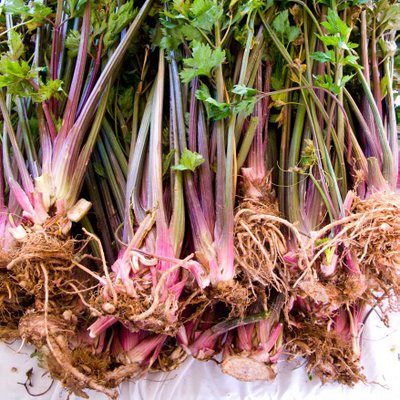Wednesday, November 05, 2008
 Celery Time
Celery TimeAs Thanksgiving nears, local celery begins to hit area farmers' markets. Here are meter-long samples of red celery found Sunday at Tom Culton's Headhouse Square stall. Soon we'll see blanched celery, which is grown (mostly) under dirt to prevent the stalks from turning green.
Don't limit yourself to raw celery. This red celery, with thin, tough stalks and coarse leaves, is much more suitable for cooking, with a more intense flavor than the common celery. Braised celery (especially the blanched variety) makes an interesting veggie alternative; you can up the interest even more by finishing with some cream. I used the red celery as the major component in a vegetable stock (along with leek, carrrots and a whole head of garlic). Most of that stock is waiting in the freezer, but I used some last night to create an ersatz caldo verde, adding diced carrots, shredded kale and chorizo, but skipping the potato.
Culton recently returned from Slow Food's Salone del Gusto 2008 in Turin, where he was bowled over by everything, but especially the prosciutto produced from a southern Italian breed of goat. Culton hopes to begin raising the breed here. (No doubt Marc Vetri, who travelled to Turin with Tom, would be interested in Culton's animal husbandry.) Because Culton's pulled out his field crops to concentrate on vegetables, he's got the acreage to create room for ruminants to ruminate. Also impressing him was Eataly, the Turin warehouse food emporium inspired by and associated with the Slow Food movement. Culton said the display of various artichokes (a crop he grows here) was as long as the Headhouse shambles.
About that cream . . .
Most of the heavy cream you come across is ultra-pasteurized for a long, stable, boring shelf life. But you can find good, old fashioned regular pasteurized cream, which hasn't been subjected to the flavor-destroying high temperatures necessary for that longevity. It's been a couple of decades since supermarkets sold the regular stuff, but you can find it at Whole Foods and at the Reading Terminal Market (Lancaster County Dairy).
Jonathan Best
The Reading Terminal Market's web site says Jonathan Best, the grocer and soup purveyor, opened this morning.
Labels: celery, cream, culton, headhouse square, jonathan best, reading terminal market, slow food
 Robert's Market Report
Robert's Market Report
